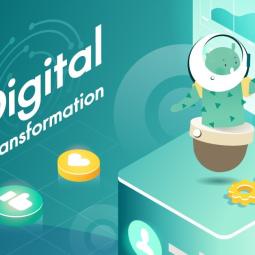Digital transformation involves using technologies to streamline and improve processes. It is a catchall term for a broad range of changes involving an organisation’s people, processes and tech platforms to improve business operations and outcomes for customers, clients and/or supporters.

Improve client outcomes and supporter engagement
Delivering services to clients and attracting supporters (and often both) are the DNA of most not-for-profit organisations. Digital transformation:
- Improves client and supporter access to services via their preferred method of interaction such as a phone, website live chat, social media channels, email, mobile app, or through a support forum
- Allows organisations to better meet client and supporter expectations
- Provides more personalised and seamless experience
- Leads to better client and supporter engagement.
Improving your organisation’s digital technologies improves client satisfaction and enhances client outcomes. For example, adopting a client/case management system will improve the capture, maintenance, access and sharing of client data across all programs and locations across the organisation.
Enhance decision-making
Working from a single source of truth, decision-makers have the right data at the right time, time spent on validating records is reduced, communication with stakeholders improves, duplication is minimised, and the information available to decision-makers benefits from better clarity, transparency, and productivity. Read more about data-driven organisations.
According to the Digital Technology in the Not-for-Proft Sector 2023 report, just 22% of organisations agree that their systems enables them to understand the impact of their services and outcomes. For two in three organisations, their data is not easy to understand or does not guide decision-making. There’s room for improvement in the not-for-profit sector in data analysis and making data-driven decision. Learn more.
Increase efficiency and productivity
Digital technologies allow organisations to be more organised and efficient through the automation of different areas of the business and streamlining processes. By implementing up-to-date technology and providing the appropriate training, manual processes are minimised, leaving staff with more time for more meaningful tasks. Examples of manual tasks that can be automated include invoicing, receipt processing, email/push notifications, payroll, report generation and distribution, email automation, claim processing, purchase orders, customer support, and more.
While digital transformation can appear expensive to implement, requiring spending on technology licences, consultancy fees and ongoing maintenance, improvements are likely to save money in the long-term. Not-for-profits can qualify for discounted technology solutions such as Microsoft nonprofit program and Google nonprofit program, and discounted hardware and software.
Promote innovation
A key benefit of digital transformation is that it promotes innovation in the organisation. Trained staff are more collaborative and agile, and exhibit enhanced capacity, longer-term focus, passion for risk, and ability to move quickly.
As the impact of the COVID-19 pandemic is being felt across the not-for-profit sector, organisations must face the challenge of shedding legacies of outdated systems and manual processes and reinventing themselves into virtual service providers. COVID-19 has accelerated digital technology adoption among staff, clients and supporters as service delivery shifts online via live stream events webinars, online training sessions and online resources. Learn more on how to set up digital technologies to enable remote work.
Digital transformation helps organisations enhance the quality of programs and resources and improves their ability to meet stakeholders’ needs. NFPs should take advantage of the potential of digital transformation and help their staff be more comfortable with innovation, adaptation and the latest digital technology advances.
Read next:
10 steps to create a digital transformation strategy roadmap





Status message
Thanks for rating this guide.